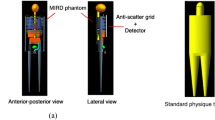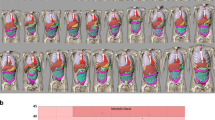Abstract
Background
Children diagnosed with congenital heart disease often undergo cardiac catheterization for their treatment, which involves the use of ionizing radiation and therefore a risk of radiation-induced cancer.
Objective
The purpose of this study was to calculate the effective and equivalent organ doses (HT) in those children and estimate the risk of exposure-induced death.
Materials and methods
Fifty-three children were divided into three groups: atrial septal defect (ASD), ventricular septal defect (VSD) and patent ductus arteriosus (PDA). In all procedures, the exposure conditions and the dose-area product meters readings were recorded for each individual acquisition. Monte Carlo simulations were run using the PCXMC 2.0 code and mathematical phantoms simulating a child's anatomy. The HT values to all irradiated organs and the resulting E and risk of exposure-induced death values were calculated.
Results
The average dose-area product values were, respectively, 40 ± 12 Gy·cm2 for the ASD, 17.5 ± 0.7 Gy·cm2 for the VSD and 9.5 ± 1 Gy·cm2 for the PDA group. The average E values were 40 ± 12, 22 ± 2.5 and 17 ± 3.6 mSv for ASD, VSD and PDA groups, respectively. The respective estimated risk of exposure-induced death values per procedure were 0.109, 0.106 and 0.067%.
Conclusion
Cardiac catheterizations in children involve a considerable risk for radiation-induced cancer that has to be further reduced.

Similar content being viewed by others
References
Thanopoulos BD, Laskari CV, Tsaousis GS et al (1998) Closure of atrial septal defects with the Amplatzer occlusion device: preliminary results. J Am Coll Cardiol 31:1110–1116
Thanopoulos BD, Karanassios E, Tsaousis G et al (2003) Catheter closure of congenital/acquired muscular VSDs and perimembranous VSDs using the Amplatzer devices. J Interv Cardiol 5:399–407
Thanopoulos B, Eleftherakis N, Tzannos K et al (2008) Transcatheter closure of the patent ductus arteriosus using the new Amplatzer duct occluder: initial clinical applications in children. Am Heart J 156:917.e1–917.e6
Martinez LC, Vano E, Gutierrez F et al (2007) Patient doses from fluoroscopically guided cardiac procedures in pediatrics. Phys Med Biol 52:4749–4759
Tapiovaara M, Lakkisto M, Servomaa A (1997) APCXMC—A PC based Monte Carlo program for calculating patient doses in medical X-ray examinations. Finnish Centre for Radiation and Nuclear Safety (STUK), Helsinki
Boothroyd A, McDonald E, Moores BM et al (1997) Radiation exposure to children during cardiac catheterization. Br J Radiol 70:180–185
Montgomery A, Martin CJ (2000) A study of the application of paediatric reference levels. Br J Radiol 73:1083–1090
Makri T, Yakoumakis E, Papadopoulou D et al (2006) Radiation risk assessment in neonatal radiographic examinations of the chest and abdomen: a clinical and Monte Carlo dosimetry study. Phys Med Biol 51:5023–5033
International Commission on Radiological Protection (2006) Biological and epidemiological information on health risk attributable to ionizing radiation: a summary of judgments for the purposes of radiological protections of humans. Annex A of Main Recommendations. ICRP Publication 103
National Research Council Committee on the Biological Effects of Ionizing Radiations (BEIR VII) (2006) Committee to access health risks from exposure to low levels of ionizing radiation. National Academy Press, Washington
Institute of Physical Sciences in Medicine, National Radiation Protection Board, College of Radiographers (1992) National protocol for patient dose measurements in diagnostic radiology. NRPB, Chilton, UK
Hart D, Jones DG, Wall BF (1996) Normalised organ doses for paediatric X-ray examinations calculated using Monte Carlo techniques. National Radiation Protection Board Report NRPB-SR279
Yakoumakis E, Tsalafoutas IA, Nikolaou D et al (2001) Differences in effective dose estimation from dose-area product and entrance surface dose measurements in intravenous urography. Br J Radiol 74:727–734
International Commission on Radiological Protection (1991) 1990 Recommendations of the International Commission on Radiological Protection. ICRP Publication 60. Pergamon Press, Oxford, UK
Christy M, Eckerman KF (1987) Specific absorber fractions of energy at various ages from internal photon sources. I. Methods. Report ORNL/TM-8381/V1. Oak Ridge National Laboratory, Oak Ridge, TN
International Commission on Radiation Units and Measurements (2005) Patient dosimetry for X-rays used in medical imaging ICRU. Report 74. Journal of the ICRU 5(2)
Eckerman KF, Cristy M, Ryman JC (1996) The ORNL mathematical phantom series. Oak Ridge National Laboratory, Oak Ridge, TN (available at http://homer.ornl.gov/vlab/mird2.pdf)
Tapiovaara M, Siiskonen T (2008) PCXMC: A Monte Carlo program for calculating patient doses in medical X-ray examinations (2nd ed) Report STUK-A231. Finnish Centre for Radiation and Nuclear Safety, Helsinki
Smans K, Tapiovaara M, Cannie M et al (2008) Calculation of organ doses in X-ray examinations of premature babies. Med Phys 35:556–568
Bacher K, Bogaert E, Lapere R et al (2005) Patient-specific dose and radiation risk estimation in pediatric cardiac catheterization. Circulation 111:83–89
Dragusin O, Gewillig M, Desmet W et al (2008) Radiation dose survey in a paediatric cardiac catheterization laboratory equipped with flat-panel detectors. Radiat Prot Dosim 129:91–95
Schultz FW, Geleijns J, Spoelstra FM et al (2003) Monte Carlo calculations for assessment of radiation dose to patient with congenital heart defects and to staff during cardiac catheterizations. Br J Radiol 76:638–647
Yakoumakis EN, Gialousis GI, Papadopoulou D et al (2008) Estimation of children’s radiation dose from cardiac catheterizations, performed for the diagnosis or the treatment of a congenital heart disease using TLD dosimetry and Monte Carlo simulation. J Radiol Prot 29:251–261
Shim D, Kimball TR, Michelfelder EC et al (2000) Exposure to ionizing radiation in children undergoing Amplatzer device placement to close atrial septal defects. Cathet Cardiovasc Interv 51:451–454
Moore JD, Shim D, Sweet J et al (1999) Radiation exposure to children during coil occlusion of the patent ductus arteriosus. Cathet Cardiovasc Interv 47:449–454
Author information
Authors and Affiliations
Corresponding author
Rights and permissions
About this article
Cite this article
Yakoumakis, E., Kostopoulou, H., Makri, T. et al. Estimation of radiation dose and risk to children undergoing cardiac catheterization for the treatment of a congenital heart disease using Monte Carlo simulations. Pediatr Radiol 43, 339–346 (2013). https://doi.org/10.1007/s00247-012-2510-3
Received:
Revised:
Accepted:
Published:
Issue Date:
DOI: https://doi.org/10.1007/s00247-012-2510-3




